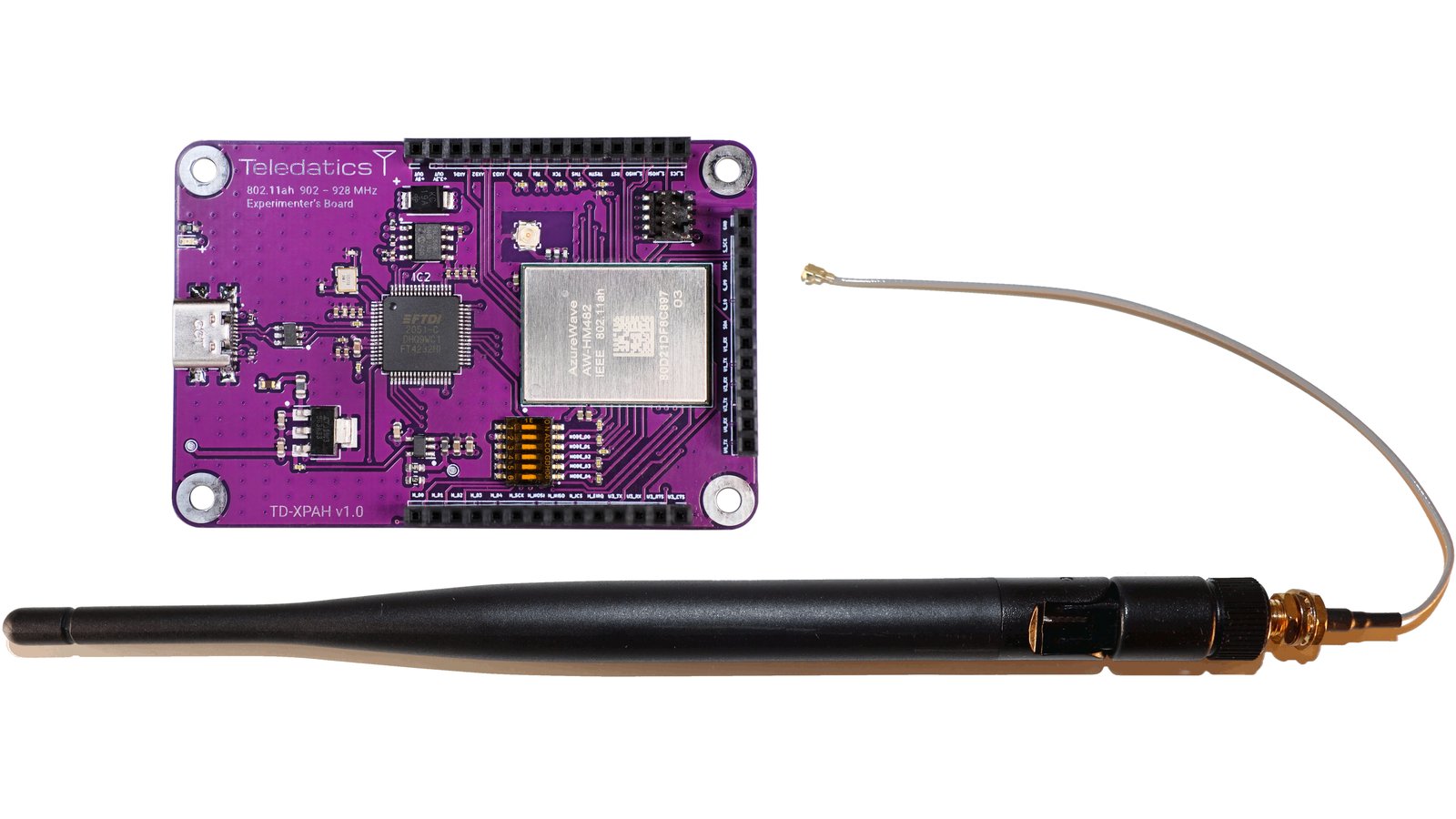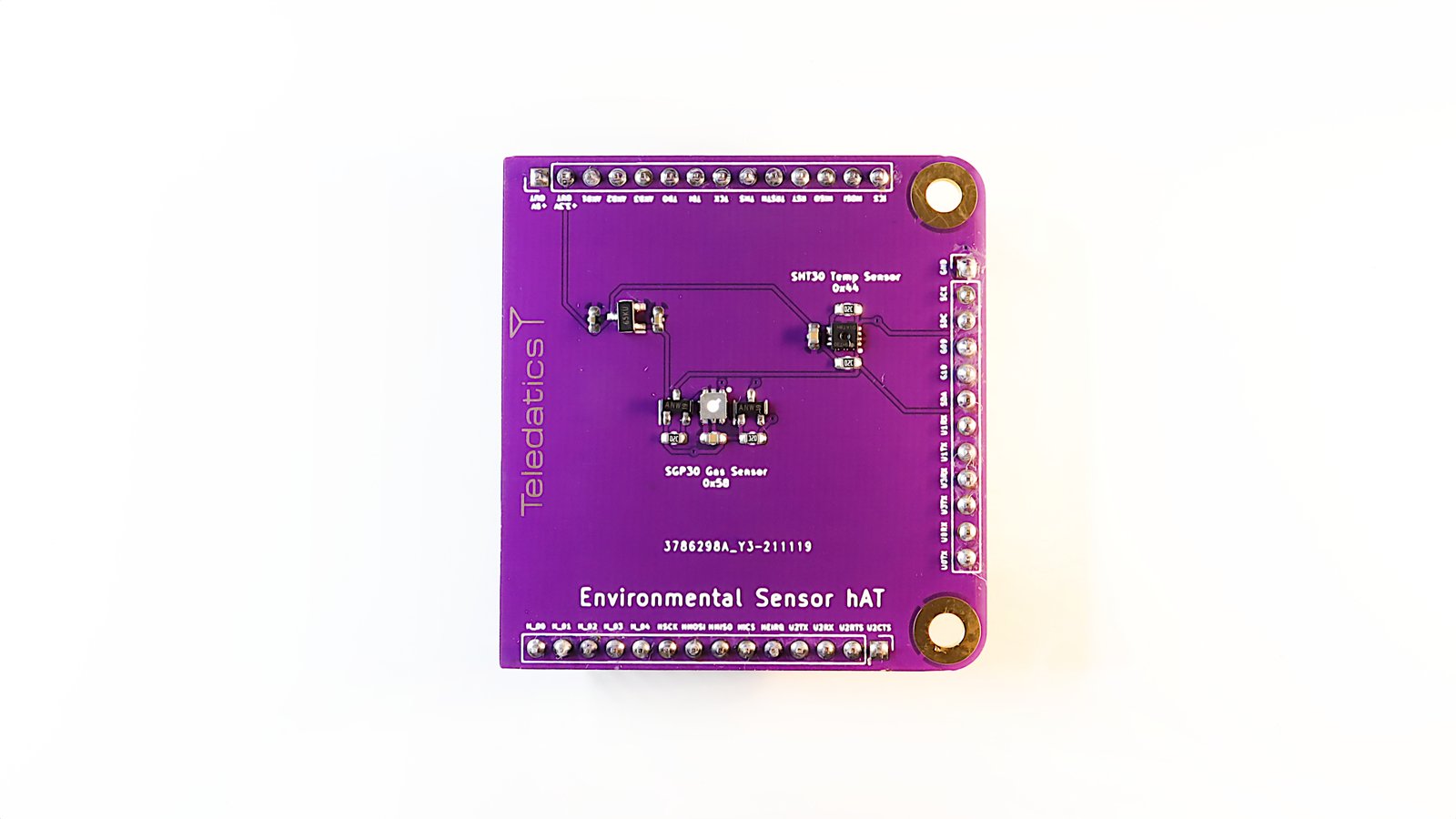Teledatics Incorporated
Wi-Fi
ARM
Teledatics Incorporated
Wi-Fi
ARM
Halo TD-XPAH is the first open source open hardware IEEE 802.11ah Wi-Fi development platform available to creators, makers, engineers and experimenters. The IEEE 802.11ah Wi-Fi protocol builds on Wi-Fi 6, adding the ability to reach a minimum of one kilometer (one-half mile) from access point to client. 802.11ah is designed to support up to several hundred clients per access point via Restricted Access Window, a form of Time Division Multiple Access (TDMA). It also supports 802.11s mesh networks where distant nodes can link to and hop through nodes closer to home to extend range further.
The TD-XPAH board supports two modes of operation: a USB dongle mode attached to an external system and a standalone mode. Since 802.11ah is a Wi-Fi protocol, the TD-XPAH supports TCP/IP and works with standard networking. Our open hardware accessory board Kicad "hAT" template can be used to create custom hardware for remote control, monitoring, and sensor systems that extend existing wired or wireless networks. We include three hardware hAT designs with the TD-XPAH launch that add Ethernet connectivity, standard 2.4 GHz Wi-Fi communication, and an air quality sensor platform.
Here’s just a few examples of what Halo TD-XPAH can do:
The maximum number of clients in traditional 2.4 GHz Wi-Fi is on the order of a dozen or so simultaneously active devices. Above this number the limited RF channel space and medium access contention issues drop available bandwidth dramatically. Wi-Fi 6 pushes this limit to several dozen devices via its expanded channel space in the 5 Ghz and 6 GHz Wi-Fi bands. But even a few dozen clients is often too few for sensor networks and distributed control systems.
The 802.11ah Wi-Fi protocol has been designed to support large numbers of clients. Our partners at Newracom, makers of the nrc7292 802.11ah chip used on the TD-XPAH, have tested well over 370 simultaneously connected clients to a single access point transferring and displaying bitmap images simultaneously.
Additionally, the 802.11ah protocol has introduced the concept of grouping client access into windows. These windows reduce contention of the available bandwidth by spreading client access across the time domain. This restricted access window (RAW) will allow up to several hundred simultaneous clients connected to each access point. To date only the 802.11ah protocol supports RAW mode. Here is a demonstration of Newracom showcasing these capabilities.
Mesh networking is a hot topic for both Wi-Fi and IoT in general. There is some debate as to what constitutes a "true" mesh network, but the gist of the idea is that devices can send data to their neighbors who in turn forward it toward its final destination. This extends the range of mesh networks to multiple hops from a gateway device such as a Wi-Fi access point.
Wi-Fi’s mesh protocol, dubbed 802.11s, became part of the Wi-Fi specification in 2011. It is a "true" mesh network in the sense that it includes a dynamic routing protocol at the mesh level. This means that nodes can come and go as they please and the protocol dynamically re-routes as the network topology changes. This is in contrast to simpler mesh protocols where the network is fixed and a disruption of the topology, such as the failure of a single node, disrupts the network itself. The TD-XPAH platform fully supports 802.11s mesh networks.
Most Wi-Fi hardware products function as either a Wi-Fi client or a Wi-Fi access point. A few offer both features, but these hybrid client/AP platforms usually need to be attached an external system. During the TD-XPAH design phase we made sure that both Wi-Fi client mode and Wi-Fi access point mode are supported. We worked with Newracom, the creators of the 802.11ah chip used in the product, to add driver support to the Linux kernel so that the TD-XPAH can be used as a Linux 802.11ah client or AP over the USB bus.
But why stop there? What about using the TD-XPAH as a standalone product? To solve this, we included support for the FreeRTOS based SDK and standalone mode. The two modes, standalone or USB dongle, are configured via a set of on-board DIP switches. And both modes, standalone or USB, support running as both a Wi-Fi client and a Wi-Fi access point. And, yes, both modes support 802.11s mesh networking as well. We designed the TD-XPAH to be used in any Wi-Fi mode, with or without an external system, configured via on-board switches with mesh networking to boot.
Demo of the TD-XPAH as a USB Wi-Fi Dongle
IEEE 802.11ah uses a new set of sub-1 gigahertz frequencies that are incompatible with traditional 2.4 GHz Wi-Fi and Wi-Fi 6. This means that, although 802.11ah is a Wi-Fi protocol and compatible with standard TCP/IP networks, 802.11ah is not available on current devices such as smartphones, tablets or PC’s. While the TD-XPAH can be used as a USB Wi-Fi dongle attached to an external Linux system, such as a PC or Raspberry Pi, attaching to existing networks is complex and requires expert network knowledge.
We are offering a 2.4 Ghz Wi-Fi Gateway hAT and an Ethernet hAT as solutions to attach to common networks and also as examples of how to build TD-XPAH hAT accessory boards. By adding either of these hAT’s to your TD-XPAH device you can connect to traditional networks over either 2.4 GHz standard Wi-Fi or over a standard Ethernet connection.
We also offer an Environmental Sensor hAT that provides remote feedback on air temperature, humidity, carbon dioxide (CO2) levels, and volatile organic compounds (VOC) levels.
| Lora | NB-IoT | Sigfox | Zigbee | Bluetooth | 5 GHz Wi-Fi | 2.4 GHz Wi-Fi | 802.11ah | |
|---|---|---|---|---|---|---|---|---|
| Signal Range | Very High | Very High | Very High | Medium | Low | Low | Medium | High |
| Power Consumption | Low | Low | Low | Low | Very Low | Medium | Medium | Low |
| Recurring Fees | No | Yes | No | No | No | No | No | No |
| TCP/IP | No | Yes | No | Yes² | Yes³ | Yes | Yes | Yes |
| Throughput in Mbps | Very Low | Low | Very Low | Low | Low | Very High | Very High | High |
| Dynamic Network Topology | Yes | Yes | No | No | Yes | Yes | Yes | Yes |
| Client Connectivity | Very High | Very High | High | Medium | Medium | Medium | Low | Very High |
| Proprietary Protocol | Yes | Yes | Yes | No | No | No | No | No |
| Mesh Capable | No | No | No | Yes⁴ | Yes | Yes | Yes | Yes |
| Security | Low | High | Low | Low | Low | High | High | Very High |
| Cost | Low | Low | Low | Low | Low | Medium | Medium | Medium¹ |
¹ Cost is rapidly decelerating
² Via 6LowPan
³ Limited or no BT network support in many devices
⁴ Fixed mesh with a single active gateway
The FCC ISM unlicensed spectrum for IEEE 802.11ah Wi-Fi is 902 - 928 MHz. We currently only support these frequencies. The EU allocates 860 - 868 MHz for 802.11ah. Because it is subject by CE restrictions, the Halo TD-XPAH cannot be shipped to EU countries, the UK, Norway, Iceland, or Liechtenstein.
"The Wi-Fi development platform can be used for a wide variety of different applications "
"[Halo] is the world’s first open source, open hardware Wi-Fi HaLow-enabled development platform aimed at engineers, creators and experimenters"
"While WiFi HaLow is another LPWAN standard, the higher bitrate enables different applications than LoRaWAN,"
Produced by Teledatics Incorporated in Westford, MA, USA.
Sold and shipped by Crowd Supply.

802.11ah development board with antenna and pigtail connector

Ethernet accessory board for the TD-XPAH

Sensor accessory board with I2C temperature, humidity, & air quality sensors for the TD-XPAH

2.4GHz Wi-Fi accessory board for the TD-XPAH

Igniting the Future with AI-Driven, Long-Range Connectivity Unleashing AI at the Network Edge